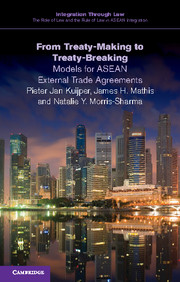Book contents
- Frontmatter
- Contents
- General editors' preface
- List of abbreviations
- 1 Introduction
- 2 Substantive components of an ASEAN trade agreement from an external perspective
- 3 Moving forward: different institutional models for ASEAN's external trade agreements
- 4 The rules on dispute settlement in agreements between ASEAN member states and third states: a critical inventory
- 5 From treaty-making to treaty-breaking
- Executive summary
- Appendix 1 Agreements signed by ASEAN member states with a non-ASEAN party
- Appendix 2 ‘Non-ASEAN’ agreements
- References
- Index
4 - The rules on dispute settlement in agreements between ASEAN member states and third states: a critical inventory
Published online by Cambridge University Press: 05 April 2015
- Frontmatter
- Contents
- General editors' preface
- List of abbreviations
- 1 Introduction
- 2 Substantive components of an ASEAN trade agreement from an external perspective
- 3 Moving forward: different institutional models for ASEAN's external trade agreements
- 4 The rules on dispute settlement in agreements between ASEAN member states and third states: a critical inventory
- 5 From treaty-making to treaty-breaking
- Executive summary
- Appendix 1 Agreements signed by ASEAN member states with a non-ASEAN party
- Appendix 2 ‘Non-ASEAN’ agreements
- References
- Index
Summary
Introduction
In the following sections we will give an inventory of, and a critical commentary on, the dispute settlement provisions included in, or annexed to, the agreements concluded between the member states of ASEAN and third states. There are five of these agreements, and their structure is variegated. Sometimes they consist of a number of different agreements linked to each other or to a declaration. Thus the agreements with Korea consist of a Joint Declaration on Comprehensive Economic Cooperation (2003), a Framework Agreement on Comprehensive Economic Cooperation (2005) and several other agreements, such as an Agreement on Trade in Goods (2006) and an Agreement on Investment (2009). The Agreement on a Dispute Settlement Mechanism with Korea (2005) is also one of these separate agreements, concluded at the same time as the Agreement on Comprehensive Economic Cooperation. A similar structure, in which an agreement on a dispute settlement mechanism constitutes one among several interdependent agreements, is found in the agreements with China and India. In the Agreement on Comprehensive Economic Partnership with Japan and in the FTA with Australia and New Zealand, the dispute settlement provisions are a chapter within one large agreement. The differences between the treaty techniques have limited influence on the substance of the dispute settlement provisions, as will be demonstrated below.
The dispute settlement provisions of the ASEAN external agreements discussed here have been strongly influenced by the Dispute Settlement Understanding (DSU) of the WTO. The parallels with the DSU will be further analysed below, with an eye to whether or not the dispute settlement provisions of the ASEAN external agreements have taken into account the well-known weak points of the DSU or, to the contrary, tend to fall below the standard set by the DSU on certain points. Special attention is given to whether the procedure is ‘watertight’ on crucial points, such as panel selection etc.
- Type
- Chapter
- Information
- From Treaty-Making to Treaty-BreakingModels for ASEAN External Trade Agreements, pp. 152 - 196Publisher: Cambridge University PressPrint publication year: 2015



